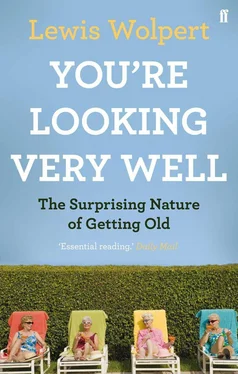As mentioned earlier, August Weismann, the great German theorist and experimental biologist of the nineteenth century, was one of the first biologists to use evolutionary arguments to explain ageing. His initial idea was that there exists a specific death-mechanism designed by natural selection to eliminate the old, and therefore worn-out, members of a population. The purpose of this programmed death of the old is to clean up the living space and to free up resources for younger generations: ‘… there is no reason to expect life to be prolonged beyond the reproductive period; so the end of this period is usually more or less coincident with death.’ Weismann probably came to this idea while reading the following notes of one of Darwin’s contemporaries and a co-discoverer of natural selection, Alfred Russel Wallace, which he later cited in his essay ‘The Duration of Life’:
…when one or more individuals have provided a sufficient number of successors they themselves, as consumers of nourishment in a constantly increasing degree, are an injury to those successors. Natural selection therefore weeds them out, and in many cases favours such races as die almost immediately after they have left successors.
But the theory is wrong, as almost all animals in the wild die before they get old. Death in the natural environment is not caused by ageing but is due to many other factors, particularly predators. Some animals like elephants do age in the wild, but such cases are rare. Wild mice die in the field at about 10 months, while in the laboratory they can live for several years. A number of animals have lifespans longer than might have been expected—for example flying birds live three times longer than land-living animals. Robins can live for 14 years but the albatross 50 years. This is because flying enabled them to escape predators and find new food sites, so early reproduction was no longer necessary. Why some reptiles like crocodiles and turtles have long lives is not clear.
The illnesses associated with ageing have a significant negative impact on human mortality. Weissman later rejected his theory, and then wisely proposed that ageing was the result of resources being given to the germ line rather than the body. If deleterious ageing occurred in germ cells, eggs or sperm, the species would die out—how right he was.
Theories concerning the ageing process emerged which are not based on it being adaptive, and thus not due to pressures of natural selection. The first was the ‘mutation accumulation’ theory, first proposed by the great scientist Peter Medawar in 1952, and referred to earlier, which proposes that mutations in the DNA of genes which lead to detrimental age-related changes in cells could accumulate over successive generations, if their serious negative effects were only expressed well after the age of peak reproductive success. These mutations are chance events. Life tables for humans show that the lowest likelihood of death in human females comes at about the age of 14, which in primitive societies would likely be an age of peak reproduction. Evolution has ensured that the peak of reproduction is when animals are young. Women lose their eggs at a more or less constant rate until they are 35, when the rate increases twofold.
Deleterious mutations expressed later in life are relatively neutral to selection because their bearers have already reproduced, and so have transmitted their genes to the next generation. As few individuals would actually reach those ages, such mutations would escape negative selective pressure—evolution would neglect them. The theory also predicts that if there are fewer external hazards for an animal, ageing will be slowed down, as is the case for animals like the albatross. According to this theory, ageing is a non-adaptive trait because natural selection is negligent of events that occur in a few long-lived animals that provide little additional contribution to offspring numbers.
Genes can be beneficial in early life, and then damaging later on. In other words, genes showing favourable effects on fitness at young ages, and deleterious ones at old age, could explain the ageing process. Such genes will be maintained in the population due to their positive effect on reproduction at young ages despite their negative effects at older post-reproductive ages, and those effects in later life will look exactly like the ageing process.
Mutation accumulation theory thus suggests that from an evolutionary perspective, ageing is an inevitable result of the declining force of natural selection with age. For example, a mutant gene that kills young children will be strongly selected against and so will not be passed to the next generation, while a lethal mutation with effects confined to people over the age of 80 will experience no selection because it has no effect on reproduction, and people with this mutation will have already passed it to their offspring by that age. Over successive generations, late-acting deleterious mutations will accumulate, leading to an increase in mortality rates late in life, which is just what we see and experience.
According to this theory, persons loaded with a deleterious mutation have fewer chances to reproduce if the deleterious effect of this mutation is expressed earlier in life. For example, patients with progeria, a genetic disease with symptoms of premature ageing, live for only about 12 years and, therefore, cannot pass their mutant genes to subsequent generations. In such conditions, the progeria is only due to new mutations and is not from the genes of parents. By contrast, people expressing a mutation at older ages can reproduce before the illness occurs; such as is the case with familial Alzheimer’s disease. As an outcome, progeria is less frequent than late diseases such as Alzheimer’s because the mutant genes responsible for the Alzheimer’s disease are not removed from the gene pool as readily as progeria genes, and can thus accumulate in successive generations. In other words, the mutation accumulation theory correctly predicts that the frequency of genetic diseases should increase at older ages.
A second theory postulates that there might be genes whose expression is harmful in later life, but which are not silent earlier in life because they are actually beneficial to survival or reproductive fitness, and have some beneficial effects. Such mutations could thus have a selective advantage in early life and then a negative one later on. These genes will be maintained in the population due to their positive effect on reproduction at young ages despite their negative effects at old post-reproductive age, and their negative effects in later life will look exactly like the ageing process. Suppose, for example, that there is a gene increasing the fixation of calcium in bones. Such a gene may have positive effects early in life because the risk of bone fracture and subsequent death is decreased, but such a gene may have negative effects later in life because of increased risk of osteoarthritis due to excessive calcification. In the wild, such a gene has no actual negative effect because most animals die long before its negative effects can be observed. There is thus a trade-off between an actual positive effect at a young age, and a potential negative one at old age; this negative effect may become effective only if animals live in protected environments such as zoos or laboratories. Costly ornaments of male birds to attract females are essential for reproduction but a burden in later life—peacocks have limited mobility.
Although these concepts as to how mutations can cause ageing have guided attempts to merge evolutionary theory with empirical studies of the biology of ageing, there is little evidence of cumulative mutations that give rise to ageing, and only rare examples of genes that display the necessary early and late functions have been found. These theories do explain the universal occurrence of ageing. But they do not explain the actual process of ageing.
Читать дальше












